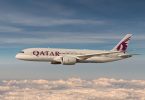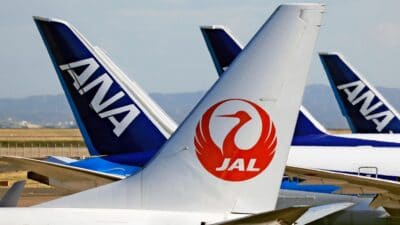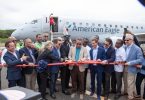That’s rarely been truer than right now, as most U.S. airline stocks are on a long slide and the best ones are measured by how little they’ve lost in value.
Over the past year, the combined market capitalization – the price of a share of stock multiplied by the number of shares outstanding – of the 10 largest airlines has plummeted 57 percent, losing $23.5 billion in value.
Excluding Southwest Airlines Co., which has stood out only because it’s down only about 12 percent, the market value of the other nine has dropped 73 percent.
An investor with a lot of money and a basic ignorance of the airline industry could buy the entire lot for less than $18 billion.
“I can’t remember a period where we have such destruction of airline values,” longtime Wall Street airline analyst Julius Maldutis said.
Mr. Maldutis, president of his own consulting firm, Aviation Dynamics, blames the entire mess on jet fuel prices. Airlines were worth a lot when fuel prices were lower two years ago; as jet fuel prices climbed, airline values plummeted, he said.
“If you go back to August in 2006, when oil prices were down about 50 percent, airlines’ stocks were up 45 percent,” Mr. Maldutis said. “Beginning in January of last year, oil prices just ratcheted up all year long, and airline stock prices came down.”
Now, fuel expenses have replaced labor costs as the biggest expense on airline operations, making the price of airline stocks even more dependent on oil prices, Mr. Maldutis said.
“The future of the U.S. airline industry is all dependent on oil,” he said.
Big drops
The hardest hit among the 10 largest carriers has been US Airways Group Inc., whose market value had declined 92 percent in the past year: from $2.7 billion on June 27, 2007, to $226 million on Friday.
The carrier, formed in September 2005 when America West Holdings Inc. merged with the previous US Airways Group and brought it out of bankruptcy protection, had soared to nearly $5.8 billion in November 2006 after it proposed a merger with Delta Air Lines Inc.
That proposal spurred a general jump in airline stock prices as investors speculated that one good merger would deserve another.
However, Delta spurned US Airways’ offer, which withdrew its bid Jan. 31, 2007. Midwest Air Group Inc. rejected a buyout from AirTran Holdings Inc. and opted for a private buyout. Other deals were rumored but never materialized.
Shares of AMR Corp., parent of American Airlines Inc., peaked at $40.66 on Jan. 19, 2007, their highest level since January 2001. But like other carriers, AMR has seen its shares slide steadily since then.
It has closed as low as $5.22 a share on June 12, finishing Friday at $5.35.
That returns AMR shares to their trading levels of spring 2003 when the company narrowly avoided a Chapter 11 bankruptcy filing.
The airlines that did file for Chapter 11 protection emerged from court proceedings with new stock with high prices. However, those heady levels haven’t been seen shortly after the shares began trading.
Delta began trading its new stock May 3, 2007. It closed that day at $20.72 a share. On Friday, it closed at $5.52, down 73 percent from its first-day close.
Northwest Airlines Corp. boasted a stock price of $25.15 on May 31, 2007, its first day of trading after exiting bankruptcy court. Like Delta, Northwest saw its shares increase in price the next trading day, then begin a slide. Its shares Friday closed at $6.31, down 75 percent from the first day.
Even the merger of Delta and Northwest, announced April 14, hasn’t kept their stock prices up. Delta shares are down 47 percent since that day, with Northwest off 44 percent.
UAL Corp., parent of United Airlines Inc., exited bankruptcy court in early February 2006, and saw its shares close at $33.90 on its first day of trading Feb. 6, 2006. On Friday, its shares were selling for $5.56 each, down 84 percent.
In fact, an investor could buy all of UAL’s stock for $700 million – or just less than six days’ net income for Exxon Mobil Corp.
But at least investors in those 10 airlines still have some money left. People who put money into such carriers as MAXjet Airways Inc., Aloha Air Inc., Skybus Airlines Inc., Eos Airlines Inc. and Silverjet PLC have seen those carriers go bankrupt and cease in the past six months.
Frontier Airlines Holdings Inc. continues to operate but has had to seek Chapter 11 protection from creditors. Champion Air Inc. and Big Sky Airways Inc. didn’t go bankrupt, but rising costs prompted them to stop operations, and shareholders of Big Sky’s owner, MAIR Inc., voted Friday to liquidate and go out of business. Mesa Air Group Inc.’s Air Midwest unit will cease operations today.
More bankruptcies?
Mr. Maldutis said that unless fuel prices abate, those airline failures are only the beginning.
“By Labor Day, we’ll have seen a whole bunch of smaller carriers shut down,” he said. “Then we’ll see the larger carrier go into Chapter 11.” If oil goes to $150 and above as some are predicting, “are we going to see virtually this entire industry in bankruptcy?” Mr. Maldutis asked.
Renowned investor Warren Buffett tried his hand in airline investing in 1989, putting $358 million into preferred stock in US Airways Group. He came away from the experience determined not to invest in airlines again, even though his company made a big profit on the investment.
That led him to make the comment that he has someone he can call to talk him out of the idea if he decides to invest in airlines again. In his annual letter to Berkshire Hathaway shareholders in February, Mr. Buffett opined:
“The worst sort of business is one that grows rapidly, requires significant capital to engender the growth, and then earns little or no money. Think airlines. Here a durable competitive advantage has proven elusive ever since the days of the Wright Brothers,” Mr. Buffett wrote.
“Indeed, if a farsighted capitalist had been present at Kitty Hawk, he would have done his successors a huge favor by shooting Orville down.
“The airline industry’s demand for capital ever since that first flight has been insatiable. Investors have poured money into a bottomless pit, attracted by growth when they should have been repelled by it,” he added.
dallasnews.com






















